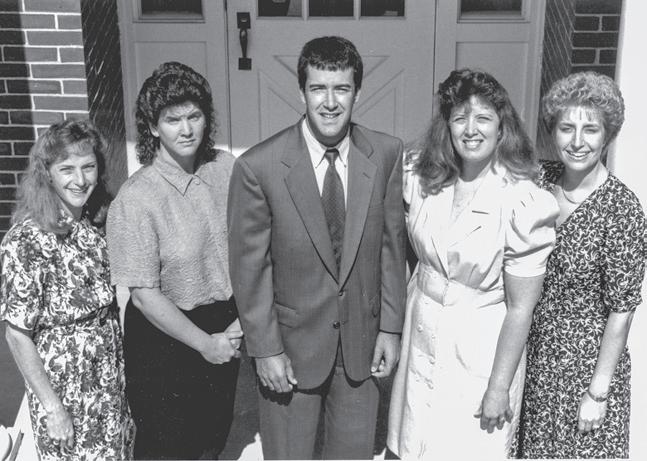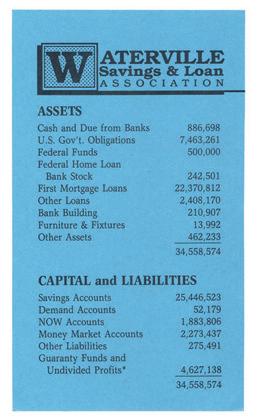
6 minute read
A History of the Tappan-Viles Mansion

Reverend Benjamin Tappan was the first inhabitant of the mansion, which was constructed in 1816.
Advertisement
e History of the Tappan-Viles Mansion
The Tappan-Viles Mansion is a vital part of Augusta’s a style exemplified by the cupola. While his political involvement vibrant history. vibrant history. transcended Maine borders, Farwell remained dedicated to Augusta. His wife donated land in front of the house for Monument Park The mansion was built for its first inhabitant, Reverend following his death. Benjamin Tappan, a Harvard graduate with ties to Bowdoin College. He made such a positive impression during his visit to Augusta’s For the next inhabitant of the Tappan-Viles Mansion, the address South Parish Church that parishioners begged him for two years to symbolized a fulfilled dream. As a young doctor in Augusta, come back and become their full-time minister. He served during a Dr. Scott W. Hill had aspired to live in the stately home. From 1867 time of doctrinal dispute, including a well-known conflict regarding to his death in 1923, his dream was realized. In 1915, he remodeled square dancing. “Scenes in a Vestry,” published in 1940, recounts the structure to reflect the Colonial Revival style of architecture. this famous trial relating to square-dancing in front of ministers to During winter months, Hill used a horse-drawn sled to visit patients. determine if it was distracting and sacrilegious. His neighbor, a professional photographer, captured images of Hill embarking on his winter rounds. Dr. Hill was on the front page of the Though Tappan remained firmly rooted in the Augusta community Kennebec Journal, reaching the age of 83 and 55 years as a doctor. through his role at South Parish Congregational Church, he also actively championed the national abolitionist movement and assumed a more far-reaching role as secretary of the Maine Missionary Society. Tappan ended his work when he was thrown from a carriage in 1862. He died the following year. After Tappan’s death, Colonel Alanson Farwell acquired the mansion. As chief clerk in the Navy Department during the Civil War and a member of the local legislature, Farwell made his mark on the building by updating the architecture from Federal to Italianate,

Dr. Scott W. Hill lived in the mansion after Tappan’s death. He was a prominent figure in the community, providing in-home care to his patients well into his 80s.

A 1927 calendar featuring a portrait of Blaine S. Viles, painted by artist Charles Relyea in the 1920s, hangs in the halls of the Tappan-Viles Mansion to this day.
Blaine S. Viles purchased the property in 1923 following Hill’s death. A graduate of Bowdoin College and Yale Forestry School, Viles served as the mayor of Augusta from 1915 to 1916 and worked as the state forest commissioner. The Viles family was the last to use the mansion as a residence.
After the Viles family’s ownership, the building was turned into office space. The building became known as the Park Circle Office Building for many years, and its occupants included Senators William Cohen and George Mitchell, the United Way of Kennebec Valley and Viles Timberlands.
In 1986, the mansion was acquired by Kennebec Savings Bank to supplement its existing property at 150 State Street. Construction soon began to attach the mansion to the 1959 modern bank property.
More than 200 years after its original construction, the mansion now serves as the headquarters of Kennebec Savings Bank. The bank president’s office is in what used to be the front parlor. Like the mansion’s former inhabitants, the Kennebec Savings Bank team prides itself on being part of Augusta’s history and giving back to the community. The mansion was refurbished once again in 2019, with many efforts made to preserve and showcase its storied history for generations to come.


Blaine S. Viles acquired the property in 1923. The Viles family was the last family to own the property before it was repurposed for professional office space.
It has been long rumored that some remnants of the distant past may still remain. Over the years, there have been several former Bank employees that reported seeing a ghostly female figure in the stairwell of the building…
It is also important to note that the mansion was constructed in 1816 during a phenomenon known as the “Year Without a Summer.” Ash from the eruption of Mt. Tambura on Sumbawa Island, Indonesia, was blocking the sunlight in New England, causing freezing temperatures and resulting in major food shortages. Six inches of snow fell in June and every month of the year had a hard frost. Temperatures dropped to as low as 40 degrees in July and August as far south as Connecticut. Despite this extreme weather, the construction of the mansion was completed and the Tappan family moved in on November 29, 1816.

The first branch office was opened in Winthrop with five employees in 1990. The Bank acquired property adjacent to the Tappan-Viles Mansion, which was the former site of a Mobil gas and service station.
Acquisitions and mergers
In 1990, Kennebec Savings Bank went online with its own in-house computer system, enabling the Bank to create its own statements rather than relying on an outside provider.
As Augusta and the population in the surrounding towns grew, so did Kennebec Savings Bank. at same year, the Bank opened its rst branch o ce at 20 Main Street in Winthrop—a property the Bank acquired from another bank, which vacated it.
In 1994, the Bank purchased property at 156 and 158 State Street at the corner of Western Avenue. e property had previously been a Mobil gas and service station. Before being acquired by Kennebec Savings Bank, the 156 State Street property was owned by local painter Joshua Heath in the mid 1800s. at property was then purchased by an Augusta photographer, John Hendee, who lived there with his family. e Warren Hendee family then lived there for 75 years until 1940 when Mobil Oil purchased the property, and opened a Socony gas station.
e 158 State Street property had been the Central House, an old tavern that was also a former residence. It was purchased in 1892 by Governor Edwin C. Burleigh, the 42nd Governor of Maine, and was called Park House at the time. Later, the tavern was relocated to the corner of Grove and Capitol Streets.

Growth in 1995 also brought about the merger of Kennebec Savings Bank and Waterville Savings and Loan Association, which had been serving northern Kennebec County since 1887. Its president and CEO, Dennis W. Matthews, became an executive vice president at Kennebec Savings Bank following the merger.
At the time of the merger, Kennebec Savings Bank’s assets were more than $190 million. Waterville Savings and Loan Association’s assets were close to $35 million.
In 1995, the Bank added a construction loan and credit card program, as well as an enhanced checking account service, which resulted in 1,000 new checking accounts that year. A third automated teller machine was installed at the Waterville branch, and overall ATM usage increased 70 percent over the prior year.



Left: Employees from Waterville Savings and Loan and Kennebec Savings Bank opened the Waterville location in 1995.
Right: At the time of the merger, Waterville Savings and Loan’s assets totaled nearly $35 million.


INTRODUCTION OF THE ATM
The Bank installed the first automated teller machine (ATM) service in 1992, providing customers with access to their funds 24 hours a day, seven days a week.











